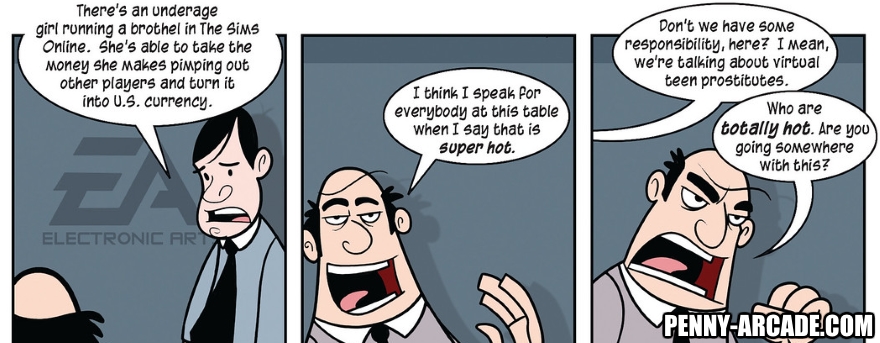
The Sims Online was one of the odder entrants into the MMO genre, an online iteration of an immensely popular game franchise that promised deeper social interaction. With Electronic Arts at its back and the Will Wright name affixed to the front, TSO (not to be confused with Cryptic’s STO) had a solid shot at cracking the big time.
It did not. It went over as well like a fish flopping out of water to make a go for it on dry land, eventually realizing that it was both going nowhere and dying slowly. The end result? It stunk.
And yet it was an interesting failed experiment in MMO gaming, especially considering that the concept wasn’t as off-base as we once thought. With social “dress up” games like Second Life and Habbo Hotel that have proved there’s interest in such activities, The Sims Online could be seen as a prophet of the future, mistreated in its own time. Return with us to the days of pixelated 2-D isometric glory, as the I interpret the Simlish of ancient tomes to uncover a forgotten history.
Add “Online” to the end of the title, advance to Go, and collect $2 billion
When The Sims hit the retail shelves in 2000, even the most ardent Will Wright fans had no idea that they’d just witnessed the birth of the biggest selling PC franchise in history. It blindsided the entire gaming population, offering creation instead of destruction, voyeurism instead of direct control, and a breakout hit among female games as well as males. There was just something addictive about the combination of creating a home and plopping down computer people to see what would happen.
With three sequels, numerous spin-offs, and approximately 16,100 expansion packs to follow, The Sims has spread like a peppy plague over the entire planet. The only thing that was missing in 2000 was the ability to interact with other people and their creations, as a multiplayer component wasn’t packaged into the first game. At the same time, online gaming was taking off and everyone wanted a piece of the EverQuest pie… so why not The Sims?
It actually made sense, in a way. Smash hit PC game, online gaming craze, cross-demographic appeal — what’s not to love? So after a period of beta testing, The Sims Online launched in December 2002.
 “Uh… so what do I do here?”
“Uh… so what do I do here?”
The Sims Online featured a world that was divided into 13 cities, each with its own feel and a few with special rules (such as one with a “hardcore” mode and another that tested new features). Players created a Sim avatar and moved into the city, staking out a plot of land on which to build their dream home.
Even though TSO had The Sims’ look and feel, players quickly realized that there were a few key differences between the single-player and online game. The first was that you controlled only one character in TSO and had to micro-manage its every action; this was in stark contrast to The Sims, where you could create a whole family of Sims who had a certain amount of free will. Because you controlled an avatar in TSO instead of letting that character “live” on its own, there was little reason to dally around your house by yourself.
The second was that your avatar didn’t get a job but instead trained up skills and then used various devices (such as the “Core Business Unit”) to earn money. Unfortunately, both skill-leveling and device-using were boring activities that largely consisted of watching a progress bar creep up slowly while players twiddled their thumbs. A small handful of jobs were added later, although these paid even less than the devices. Soon enough, players were asking, “Uh… so what do I do here?”
Because there were relatively few skills and jobs to engage in, enterprising players would create bizarre “homes” that featured rows of skill items and job devices for the community to use. People could save money by not having to buy these items, and in return the home owners asked for tips as crowds came and went. It was a system that became functional but not fun. EA added other ways for players to make money, such as selling items or renting out a home, but the economy struggled to become fully featured for the entire duration of the game.
It got even worse. In 2005, the economy was flooded with cash due to an exploit. This involved a shopping rack that produced more money than it should have, which was then mined for days by players before the devs fixed it. By then it was too late, and the economy was thrown out of whack for years afterward.
On the plus side, The Sims Online certainly contained a wealth of tools and toys for players to build their dream homes. Depending on what category a player chose for his land, such as “Entertainment” or “Shopping,” different items became available to purchase and use. While players could not create or submit their own items, TSO had enough goodies to keep creative players busy once they had enough money, and impressively bizarre and beautiful houses came into being.
Some players channeled their creativity into other TSO-related outlets, including a round-the-clock radio station. Carbine’s Stephanie Morrow recalled fond memories of working a DJ gig in the game: “I met a lot of awesome people through my little job as an online radio DJ and got over a lot of my shyness of public speaking. I learned that I actually enjoyed talking to others a great deal, and after doing online DJing for a few months I even decided I was (gasp) good at it. It’s something that I remember in great detail even to this day, despite the fact that I barely played The Sims Online for more then two months before deciding I just didn’t have the patience for it any more.”
But basically other than skill grinding, job grinding, and building a home, there really wasn’t much to do in The Sims Online other than just talk to other players — which made the game a subscription-based graphical chat room at best. And once people came to that conclusion, this began to happen:
 Meet Market Online
Meet Market Online
Around this time, the game’s sordid underbelly began to show. In two of its strips, Penny Arcade accurately identified the actual draw of TSO: hooking up with other people and cyber-prostitution. As an alternative way to earn money, players began to sell certain… services for in-game money, an activity that became a serious problem when minors (who were everywhere in TSO) became involved.
I don’t think EA foresaw brothels and meat markets being the result of the title, but with a lack of interesting content and gameplay, it’s easy to see now that this was the inevitable result. Throw in underage hanky-panky and RMT for gambling and brothels, and EA’s gaming utopia had crumbled into a seedy red-light district.
 Riding into the sunset
Riding into the sunset
While The Sims Online rapidly fell out of the public consciousness, the game itself continued to operate for well over a half-decade. The game grew long in the tooth, especially as most other MMOs (and subsequent Sims titles) went 3-D while TSO was stuck with primitive, flat 2000-era graphics.
Seeing its numbers slipping, EA wiped the servers in early 2008, pushed all of the players into one large city, and repackaged the title as EA-Land. Why EA changed the name to that abomination is beyond me, especially considering that The Sims label was one of the biggest things going for the game.
Initially, there was hope for this change, as players were told that they could buy and sell property as well as submit user content. EA-Land was also completely free-to-play, ridding itself of The Sims Online’s subscription fee. However, shortly thereafter the decision was made to pull the plug later that year, creating a brief period of time called “EA-Land Sunset.” On August 1, 2008, the MMO finally shut its doors for good.
It was an inauspicious end to the game, swept under the rug while other Sims titles continued to rocket to glory and (more importantly) gigantic sales numbers. Maybe if The Sims Online had waited a few years for better technology and design, it could have truly been something. And maybe it’s an idea worth revisiting for EA, which never seems to tire of milking the franchise if there’s a buck to be had.
 Believe it or not, MMOs did exist prior to World of Warcraft! Every two weeks, The Game Archaeologist looks back at classic online games and their history to learn a thing or two about where the industry came from… and where it might be heading.
Believe it or not, MMOs did exist prior to World of Warcraft! Every two weeks, The Game Archaeologist looks back at classic online games and their history to learn a thing or two about where the industry came from… and where it might be heading.













